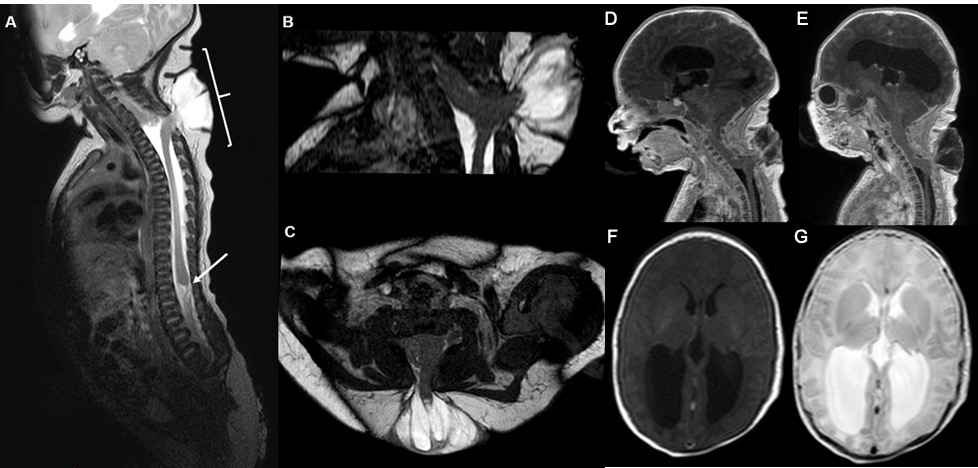Cervical Myelomeningocele associated with Chiari II and Caudal Regression Syndrome
DOI:
https://doi.org/10.46900/apn.v4i1(January-April).84Keywords:
Myelomeningocele, Caudal Regression Syndrome, Chiari II, Spine, Spinal dysraphismAbstract
Myelomeningocele (MMC) is an open spinal dysraphism that results from faulty primary neurulation due to defective closure of the neural tube [1,2]. It usually involves the lower lumbar and sacral regions and is rare in cervical and upper thoracic spine [2]. MMC is often associated with hydrocephalus and Chiari II malformation, which involves cerebellum, brain stem, skull base and spine [2].
Caudal regression syndrome (CRS) is a rare and sporadic neural tube defect that affects distal spinal segments and causes maldevelopment of the spinal cord, with etiology still uncertain, although it may be associated with maternal diabetes, genetic factors and hypoperfusion [3].
Other cases of meningocele associated with CRS have been reported [4], however, as far as we know, there is no report of cervical MMC in association with CRS.
We illustrate the case of a female child, born by cesarean section, at term (38w1d), who presented cervical/upper thoracic myelomeningocele associated with caudal regression syndrome (Fig. 1) and Chiari II (Fig. 2). On physical examination, the patient was hydrated, active, reactive, normal-colored, anicteric, with congenital clubfoot (talipes equinovarus) on the left and vertical talus on the right, with hypotrophy of the left lower limb. Abdominal ultrasound showed mild hydronephrosis, and cystourethrography was suggestive of neurogenic bladder. The echocardiogram showed ostio secundum atrial septal defect measuring 2.3 mm. The electroencephalogram did not show significant alterations. Her mother had a history of toxoplasmosis and pre-eclampsia during pregnancy.
According to Renshaw’s classification, the patient was defined as type II, which refers to partial sacral agenesis with a bilaterally symmetrical defect, a normal or hypoplastic sacral vertebra, and a stable articulation between the ilia and first sacral vertebra [5].
LEGENDS:
MRI image of cervical, thoracic and lumbar spine in sagittal section, T2-weighted, shows spinal dysraphism with defective posterior elements at the level of the cervical-thoracic transition (C7-D2), with myelomeningocele (bracket) (A). Conus medullaris showing increased thickness, with abrupt ending (arrow) (A). Hypoplastic sacrococcygeal vertebrae, a finding suggestive of caudal regression syndrome (A). T2-Weighted MRI images of the cervical spine in sagittal (B) and axial (C) planes, show herniation of neural tissue and meninges through an open spinal dysraphism, compatible with myelomeningocele.
Brain MRI images in post-contrast T1-weighted sequences in sagittal plane show findings suggestive of Chiari II malformation: small posterior fossa, inferior displacement of the cerebellar tonsils through the foramen magnum, small 4th ventricle and supratentorial hydrocephalus (D,E). Axial Brain MRI T1-weighted (F) and T2-weighted (G) sequences show a colpocephalic pattern of the supratentorial ventricular system.
Submited: 17 February 2021
Accepted: 11 October 2021
Published: 10 October 2021 (online)
Downloads
References
1. Kumar J, Afsal M, Garg A. Imaging spectrum of spinal dysraphism on magnetic resonance: A pictorial review. World J Radiol. 2017 Apr 28;9(4):178-190. doi: 10.4329/wjr.v9.i4.178.
2. Tortori-Donati P, Rossi A, Cama A. Spinal dysraphism: a review of neuroradiological features with embryological correlations and proposal for a new classification. Neuroradiology. 2000;42:471–491.
3. Singh SK, Singh RD, Sharma A. Caudal regression syndrome - case report and review of literature. Pediatr. Surg. Int. 2005;21 (7): 578-81. doi:10.1007/s00383-005-1451-4.
4. Gillis CC, Bader AA, Boyd M. A tail of sacral agenesis: delayed presentation of meningocele in sacral agenesis. Eur Spine J 2013;22(suppl 3):311–6
5. Renshaw TS. Sacral agenesis. The Journal of Bone & Joint Surgery: Apr 1978 - Volume 60 - Issue 3 - p 373-383

Additional Files
Published
How to Cite
Issue
Section
License
Copyright (c) 2021 Mariana Santos Leite Pessoa, Ana Carla Farias Pimentel, José de Aguiar Ramos Neto, Eveline Oliveira Girão de Castro, Pablo Picasso de Araújo Coimbra, Daniel Gurgel Fernandes Távora

This work is licensed under a Creative Commons Attribution 4.0 International License.

When publishing in Archives of Pediatric Neurosurgery journal, authors retain the copyright of their article and agree to license their work using a Creative Commons Attribution 4.0 International Public License (CC BY 4.0), thereby accepting the terms and conditions of this license (https://creativecommons.org/licenses/by/4.0/legalcode).
The CC BY 4.0 license terms applies to both readers and the publisher and allows them to: share (copy and redistribute in any medium or format) and adapt (remix, transform, and build upon) the article for any purpose, even commercially, provided that appropriate credit is given to the authors and the journal in which the article was published.
Authors grant Archives of Pediatric Neurosurgery the right to first publish the article and identify itself as the original publisher. Under the terms of the CC BY 4.0 license, authors allow the journal to distribute the article in third party databases, as long as its original authors and citation details are identified.





























